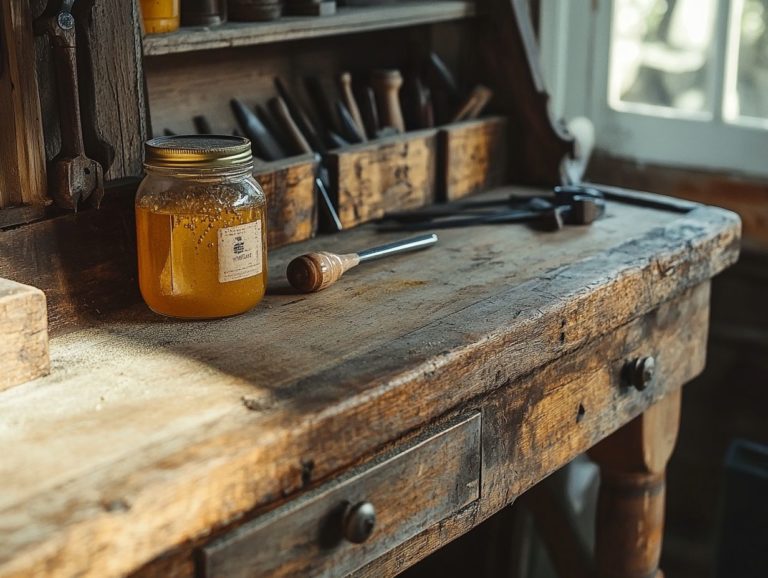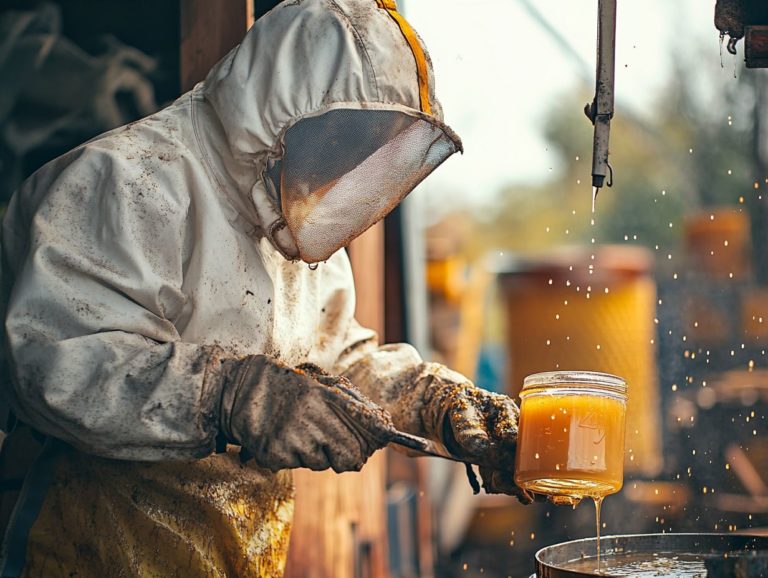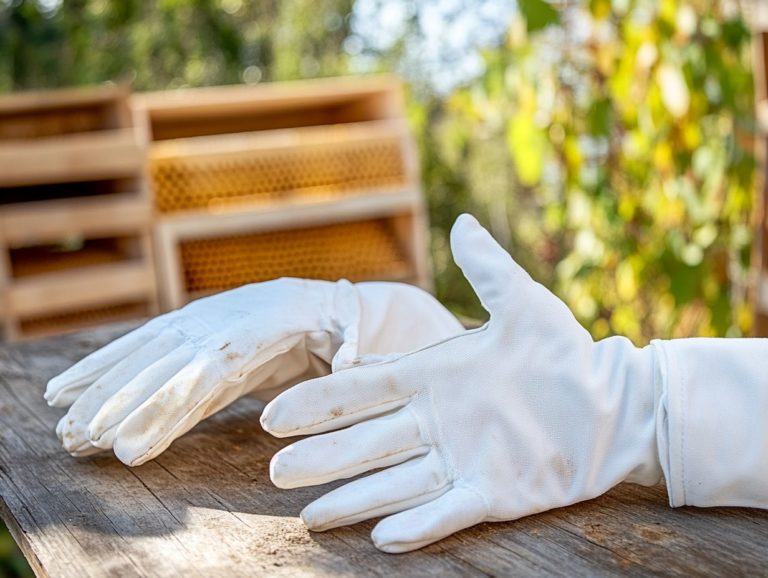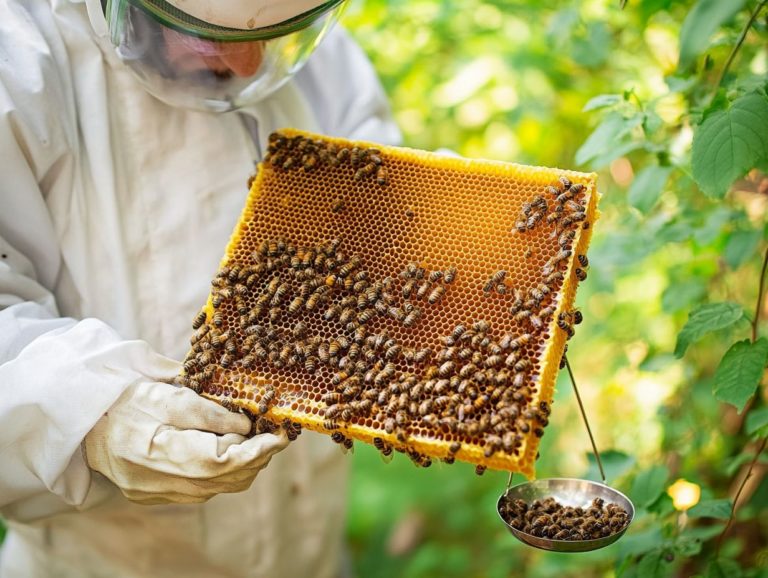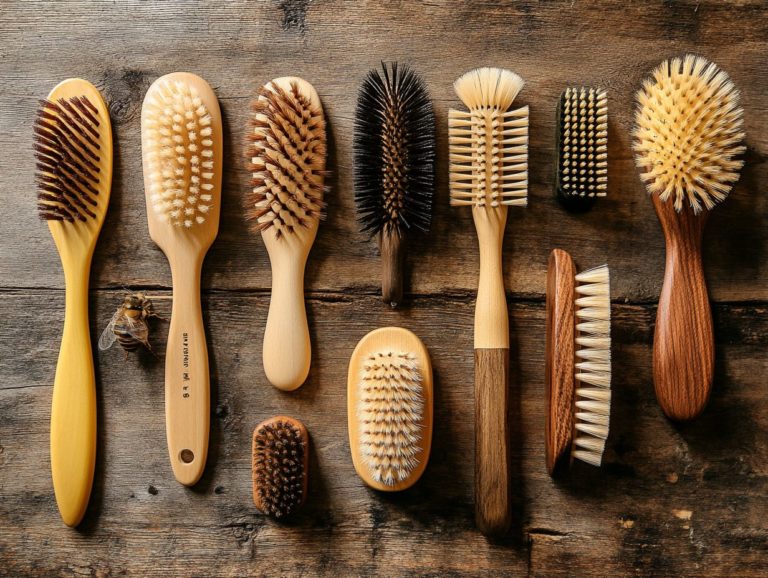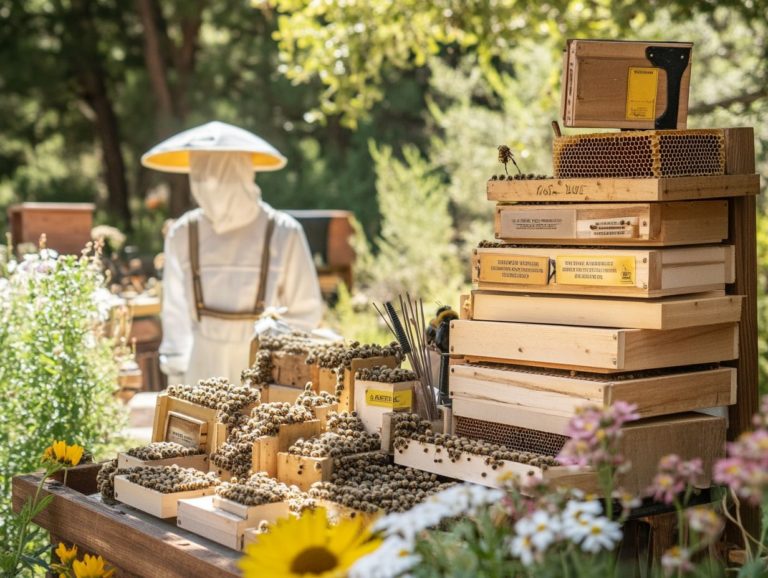The Importance of Equipment for Bee Safety
Beekeeping is not just a rewarding endeavor; it deepens your appreciation for the intricacies of nature. However, it does come with risks, including bee stings and heat stress.
Understanding the significance of bee safety is essential, whether you re a novice or a seasoned beekeeper. This article explores the critical beekeeping equipment, such as a bee smoker and protective clothing, necessary for ensuring your safety while working with these captivating creatures.
From protective clothing to specialized tools like the hive tool and smoker, you ll discover the gear that shields you from stings and those occasionally aggressive bees. This gear also enhances your overall beekeeping experience.
Join us on this thrilling journey into the world of beekeeping as we unveil the best practices for remaining safe while immersing yourself in this fulfilling hobby.
Contents
- Key Takeaways:
- Why is Bee Safety Important?
- What Equipment is Needed for Bee Safety?
- What are the Different Types of Protective Clothing for Beekeeping?
- How Can Protective Clothing Help with Bee Safety?
- What Other Equipment Can Help with Bee Safety?
- Frequently Asked Questions
- What is the importance of safety equipment for bee safety?
- What are some essential beekeeping equipment for bee safety?
- Why is it important to wear protective clothing like a bee suit?
- What are the benefits of using a bee smoker?
- Can bee safety equipment prevent bee stings completely?
- How often should beekeeping equipment be inspected and replaced?
Key Takeaways:
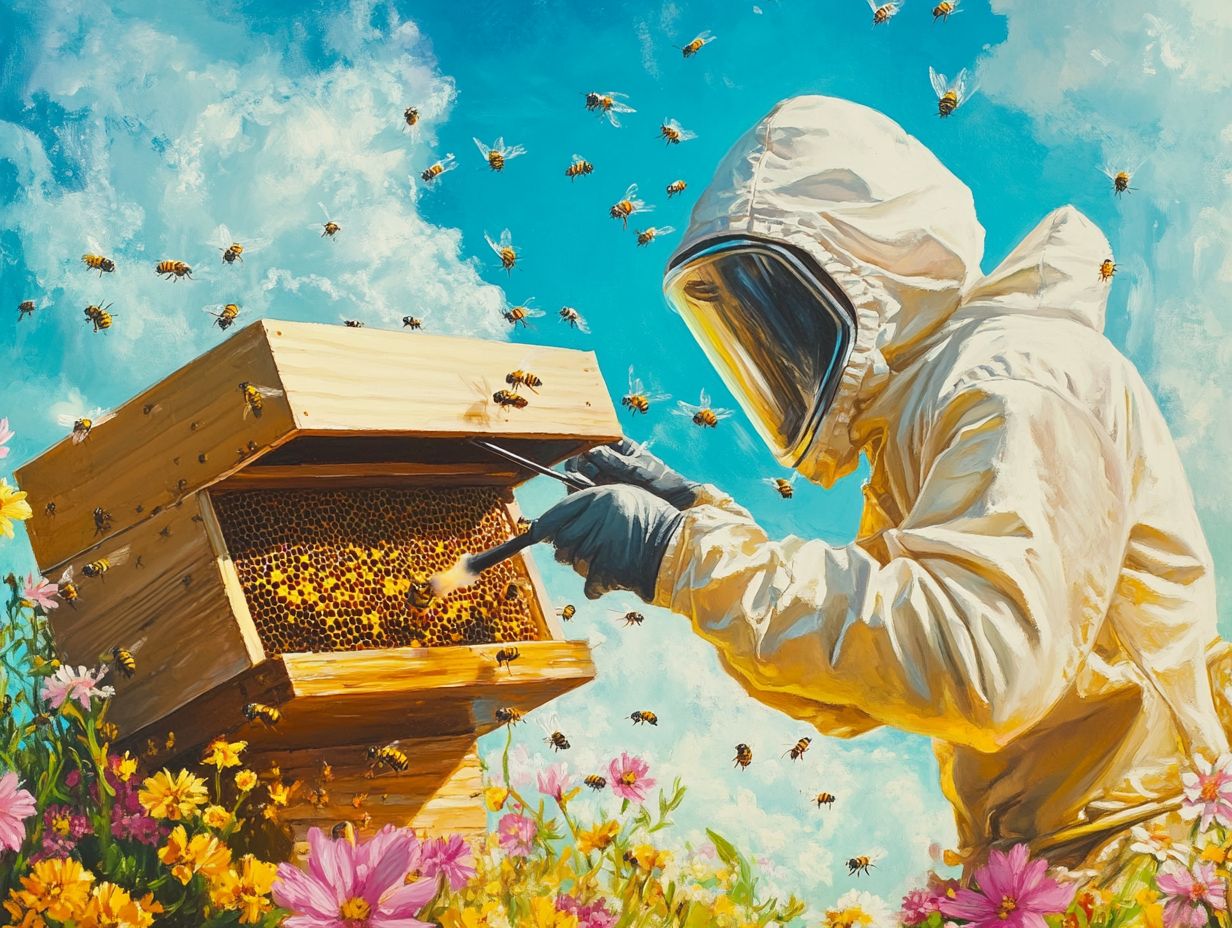
- Bee safety is crucial for both beekeepers and the bees themselves.
- Protective clothing, such as a bee suit and gloves, is essential for bee safety.
- Other important equipment for bee safety includes a smoker, hive tool, and honey extractor.
Why is Bee Safety Important?
Bee safety is essential for you as a beekeeper and for the honey bees themselves. It minimizes the risk of bee stings and creates a secure working environment in your apiary (the place where beehives are kept). By using effective safety practices and appropriate equipment, you can prevent accidents and improve your overall beekeeping results.
Focusing on bee safety elevates your beekeeping experience while safeguarding the well-being of the bees. This nurtures a more sustainable relationship between humanity and nature. Understanding how bees react to different situations is crucial; this knowledge helps you respond appropriately and maintain a calm atmosphere during hive inspections. Additionally, having a first aid kit on hand is vital for treating any incidents.
What Equipment is Needed for Bee Safety?
To ensure the safety of bees, you must understand the key beekeeping equipment. This includes protective clothing like bee suits, gloves, and a beekeeping veil, which protects you from stings while working in the apiary.
Tools such as the hive tool and smoker are critical for managing the bees and safely opening hives. Each piece of equipment, including a queen excluder and wax foundation, fosters a safe environment where both you and the honey bees can thrive together.
Investing in high-quality beekeeping gear, including appropriate ventilation and plastic frames, significantly minimizes the risk of bee-related injuries and elevates your overall beekeeping experience.
1. Protective Clothing
Protective clothing is essential for bee safety, carefully made to shield you from stings during hive inspections. This gear includes full bee suits that cover your entire body and bee veils to protect your face and neck.
Good protective clothing helps reduce negative bee reactions. This ensures a more fruitful beekeeping experience. Join a beekeeping club to stay updated with best practices!
Lightweight jackets are another option. They offer flexibility and comfort while still providing protection, made from materials that let air through for warm days.
You ll find bee veils in various styles, such as round or square, which provide extra protection for sensitive facial areas. These often feature fine mesh for clear visibility.
The materials used, like cotton blends and reinforced synthetics, ensure durability against stings and wear. A proper fit is essential; ill-fitting gear can compromise protection and comfort.
Regular maintenance and washing are vital to keep your gear effective and in good condition for safe and productive beekeeping practices. You ll feel safe and confident in your gear!
2. Beekeeping Gloves
Beekeeping gloves are a key part of your protective gear, designed to shield your hands from stings while you manage your hives.
You’ll find these gloves in various styles to suit your needs, including:
- Fully leather options
- Cotton with leather palms
- Robust synthetic materials
Each type has its own advantages and disadvantages. Sizing is also crucial; select gloves that match your hand size, ranging from small to extra-large, for a snug fit. The right gloves provide protection and enhance your ability to move your fingers easily.
To prolong the lifespan of your gloves, regularly clean them and store them in a dry place. Many beekeeping enthusiasts recommend brands like Bee Built and WLC for their durability and comfort.
3. Beekeeping Veil
A beekeeping veil is an essential piece of protective clothing that safeguards your face and neck from bee stings. Made from lightweight, breathable materials, this gear ensures you can see and stay comfortable while tending to your bees.
The design prevents bees from reaching your face, allowing you to manage hives confidently without worrying about stings on sensitive areas.
You’ll find a variety of beekeeping veil styles, each catering to different preferences. Some veils have hats for extra protection and sunshade, while others integrate with full bee suits for comprehensive coverage.
When selecting a veil, prioritize visibility and breathability. Clear mesh allows unobstructed views, and ventilated materials help prevent overheating. Assess your personal comfort and specific beekeeping activities when choosing.
Regular inspections for tears are crucial for maintaining the veil’s integrity. Proper cleaning typically through hand washing with mild detergent prolongs its usability. Consult the Country Fire Authority guidelines for best practices in maintaining your beekeeping equipment.
Don’t wait! Explore your protective gear options today for a safe beekeeping experience!
4. Beekeeping Smoker
A beekeeping smoker is an essential tool for managing honey bees. It plays a crucial role in ensuring their safety during hive inspections. This device generates cool smoke that calms the bees, significantly reducing the chances of aggressive behavior and potential stings.
Using a smoker before opening the hive sets the stage for a more tranquil interaction with your bees. This makes inspections and honey harvesting much safer. Mastering the proper operation of a smoker is vital for maintaining optimal hive conditions and keeping your bees calm and manageable.
This essential tool works by burning various organic materials, like pine needles, burlap, or wood shavings. It produces smoke that effectively masks the alarm pheromones chemicals bees release when they feel threatened. Before you approach the hive, a few puffs of smoke can create a soothing cloud, encouraging the bees to shift their focus from defense to food storage.
Regular cleaning of the smoker and ensuring it’s always filled with the right materials are important maintenance tasks that enhance its efficiency. Check the airflow and ensure the nozzle is clear to prevent any blockages that could compromise its functionality. By following these best practices, you can elevate your beekeeping experience to new heights!
5. Hive Tool
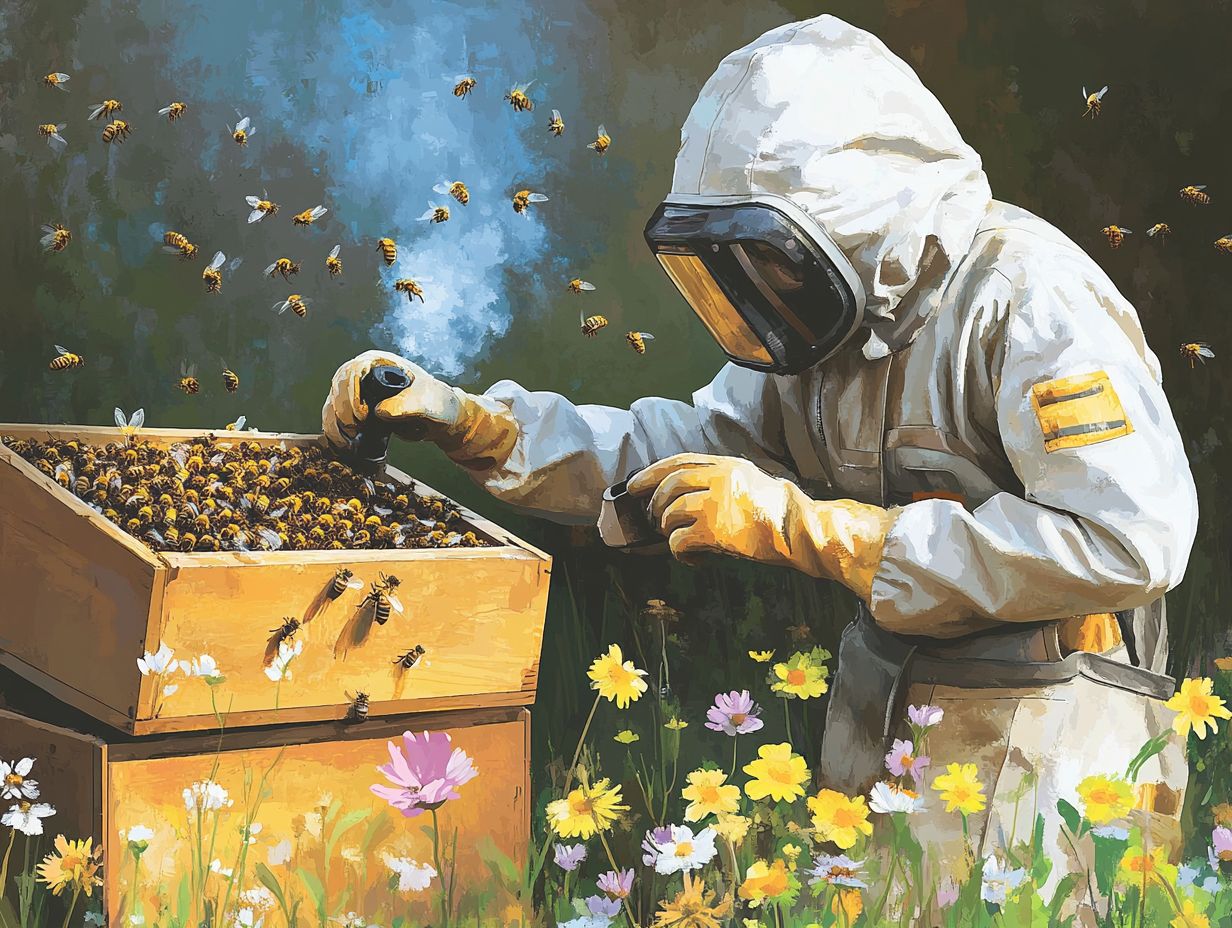
The hive tool is an essential companion in your beekeeping journey. It serves multiple functions that enhance the safety of your bees and streamline your hive inspections. This versatile tool allows you to open hives, scrape off excess wax, and pry apart hive components. It is vital for the thorough and safe management of your bee colonies.
By using a hive tool effectively, you can minimize disruptions to the bees, reducing the likelihood of aggressive reactions and those pesky bee stings. A well-maintained hive tool not only simplifies your beekeeping experience but also promotes the safety of both you and your bees!
Its design typically features a flat edge for prying and a curved end for scraping. This makes it easy to tackle various hive tasks like inspecting brood frames or managing wax buildup. When choosing a hive tool, prioritize materials that boast durability and resistance to corrosion. Stainless steel is often recommended for its strength and longevity.
To keep your tool in top shape, remember to clean it regularly after each use to prevent sticky residue buildup. Store it in a dry, safe place to avoid rust. Many experienced beekeepers prefer tools that offer a comfortable grip and balanced weight, enhancing maneuverability during inspections and making the entire process more efficient!
What are the Different Types of Protective Clothing for Beekeeping?
Whether you’re lifting hives or managing wax foundations, the right protective clothing can make all the difference in your beekeeping activities.
In terms of protective clothing for beekeeping, you’ll find a range of options tailored to meet your specific needs and preferences. All these options aim at keeping you safe during hive inspections. It’s also essential to consider additional beekeeping equipment such as a bee veil and beekeeping gloves for complete protection.
Standard choices include full bee suits that envelop your entire body, delivering maximum protection. If you’re looking for versatility and breathability in warmer conditions, bee jackets might be just the ticket. Make sure to have a first aid kit on hand as a precaution against potential bee stings.
Beekeeping coveralls are another excellent option. They combine full-body coverage with ease of use, ensuring comfort during those longer hours spent in the apiary. Proper ventilation in your clothing helps prevent heat stress during long hours in the sun.
Choosing the right type of protective clothing is crucial for minimizing the risk of bee stings and creating a safe working environment while engaging with the fascinating world of honey bees! Join a beekeeping club to gain valuable insights into selecting and using the right safety equipment.
Explore your options today to ensure the best safety while working with bees!
1. Bee Suit
A bee suit serves as the ultimate protective gear for your beekeeping endeavors, meticulously designed to offer maximum defense against those pesky bee stings while you work in the apiary. Crafted from durable yet breathable fabrics, bee suits envelop your entire body, including critical areas like your arms, legs, and torso, ensuring you can operate safely even in high-stress situations.
Many of these suits come with integrated hoods and veils, adding an extra layer of security by keeping those buzzing bees away from your face and neck. By donning a high-quality bee suit, you significantly diminish the risk of injuries, enabling you to manage your colonies with unwavering confidence.
In terms of selecting the most suitable bee suit, consider a variety of materials such as cotton, synthetic blends, or even specialized fabrics that offer specific benefits like water resistance or heat retention. Each material brings its own set of advantages; for example, cotton suits are generally breathable and comfortable, while synthetic options tend to be more durable and easier to clean.
As you ponder the right fit and style, remember to prioritize both comfort and functionality. Look for features like multiple pockets for your tools, ample ventilation to keep cool during those warm months, and adjustable hoods that help maintain visibility without sacrificing safety.
Regular maintenance and proper cleaning are essential gentle washing methods and air-drying will help ensure your suits remain in optimal condition, prolonging their lifespan and effectiveness. By considering these factors, you can find an outfit that perfectly meets your needs, allowing you to work efficiently and safely alongside your buzzing companions.
2. Bee Jacket
Protective clothing like a bee jacket is essential for minimizing risk in your apiary.
A bee jacket serves as an exceptional choice for you as a beekeeper, striking the perfect balance between protection and comfort while you manage your hives. This type of protective clothing covers your upper body and typically includes a hood or veil to safeguard your face from any potential bee stings.
Designed with lightweight materials, bee jackets facilitate breathability and allow for effortless movement during your hive inspections, especially in warmer weather. By offering essential protection without the bulk of a full bee suit, bee jackets become the go-to option for beekeepers like you who seek flexibility and comfort in their apiary activities.
Not only are these jackets ideal for sunny days, but they also adapt seamlessly to various weather conditions, providing sufficient insulation for cooler temperatures when layered appropriately. When choosing a bee jacket, it s crucial to select the right size and style opt for options that fit snugly around the cuffs and waist to keep those pesky bees from making an unwelcome entrance.
Look for key features such as pockets for your tools and good ventilation, which are vital for enhancing functionality. Don t forget to include a hive tool for easily opening hives and a smoker to calm the bees. To ensure your jacket remains effective and lasts for years, make it a habit to wash it regularly with mild detergent and store it properly in a dry, cool place.
3. Beekeeping Coveralls
Complete your set of protective clothing with a pair of beekeeping gloves for added safety.
Beekeeping coveralls provide you with full-body coverage. They deliver a comfortable and practical option for those who prioritize safety against bee stings. These garments beautifully combine the advantages of both a bee suit and a bee jacket, ensuring your entire body is shielded.
Typically, beekeeping coveralls boast reinforced seams and breathable materials. This allows you to move freely while ensuring maximum protection. When you wear coveralls, you can confidently manage your apiary without the nagging fear of bee stings affecting your experience.
The fabric used in these coveralls often includes a blend of cotton and synthetic materials. This enhances durability and comfort, making them perfect for those long hours spent among the hives. A well-designed coverall comes complete with a fitted hood, elastic cuffs, and adequate length to minimize any gaps where bees might sneak in.
Unlike other protective clothing options, beekeeping coveralls offer a comprehensive shield while still allowing for flexibility. This liberates you from the restrictions often found in heavier gear. When selecting your size, ensure you have enough room for movement without it being overly baggy.
Regular maintenance like gentle washing and checking that the zippers and seams remain intact will extend the life of these essential garments. This keeps them both clean and effective against the rigors of the beekeeping environment. Using plastic frames can help manage the hive more efficiently.
How Can Protective Clothing Help with Bee Safety?
Consider taking courses or advice from organizations like the Country Fire Authority on managing beekeeping in rural areas.
Protective clothing is essential for enhancing your safety as a beekeeper. It offers reliable defense against bee stings and decreases the chances of unwanted bee reactions during hive inspections.
By donning specialized gear like bee suits, gloves, and veils, you create a secure working environment while minimizing stress on the honey bees. This attire does more than just shield you from stings; it cultivates a calm atmosphere that allows you to carry out your tasks with confidence. Using a bee smoker a tool that calms bees during hive inspections can further reduce the chance of bee reactions.
Ultimately, investing in adequate protective clothing is vital for fostering a harmonious relationship between you and your bees. Consult resources like The Lancet for the latest research on bee safety and protective measures.
1. Protection from Stings
One of the standout benefits of protective clothing is its remarkable capacity to shield you from bee stings a common worry for beekeepers during hive management. By equipping yourself with high-quality beekeeping gloves, suits, and veils, you can dramatically lower the risk of painful encounters while working closely with honey bees. Having a first aid plan in place can also prepare you for any unexpected stings.
This protective gear reliably protects you, minimizing direct contact. This allows you to concentrate on your tasks without the looming fear of injury. Enhanced protection from stings transforms your beekeeping experience into something far more enjoyable and productive.
The materials employed in protective clothing, such as durable heavy canvas or specialized polyester blends, offer exceptional longevity and resistance to bee venom. Many suits come with elastic cuffs and secure closures that prevent bees from sneaking inside while providing a comfortable fit. Make sure to inspect your gear regularly for any signs of wear and tear.
The design of these garments is equally important; lighter colors are less likely to provoke bees, reducing the chances of aggressive behavior. Furthermore, the psychological boost from feeling secure in your protective clothing can significantly enhance your mental state as a beekeeper.
When shielded from potential harm, your anxiety levels decrease, resulting in improved focus and efficiency in your beekeeping tasks. Ultimately, this fosters a deeper passion for your craft.
2. Protection from Aggressive Bees
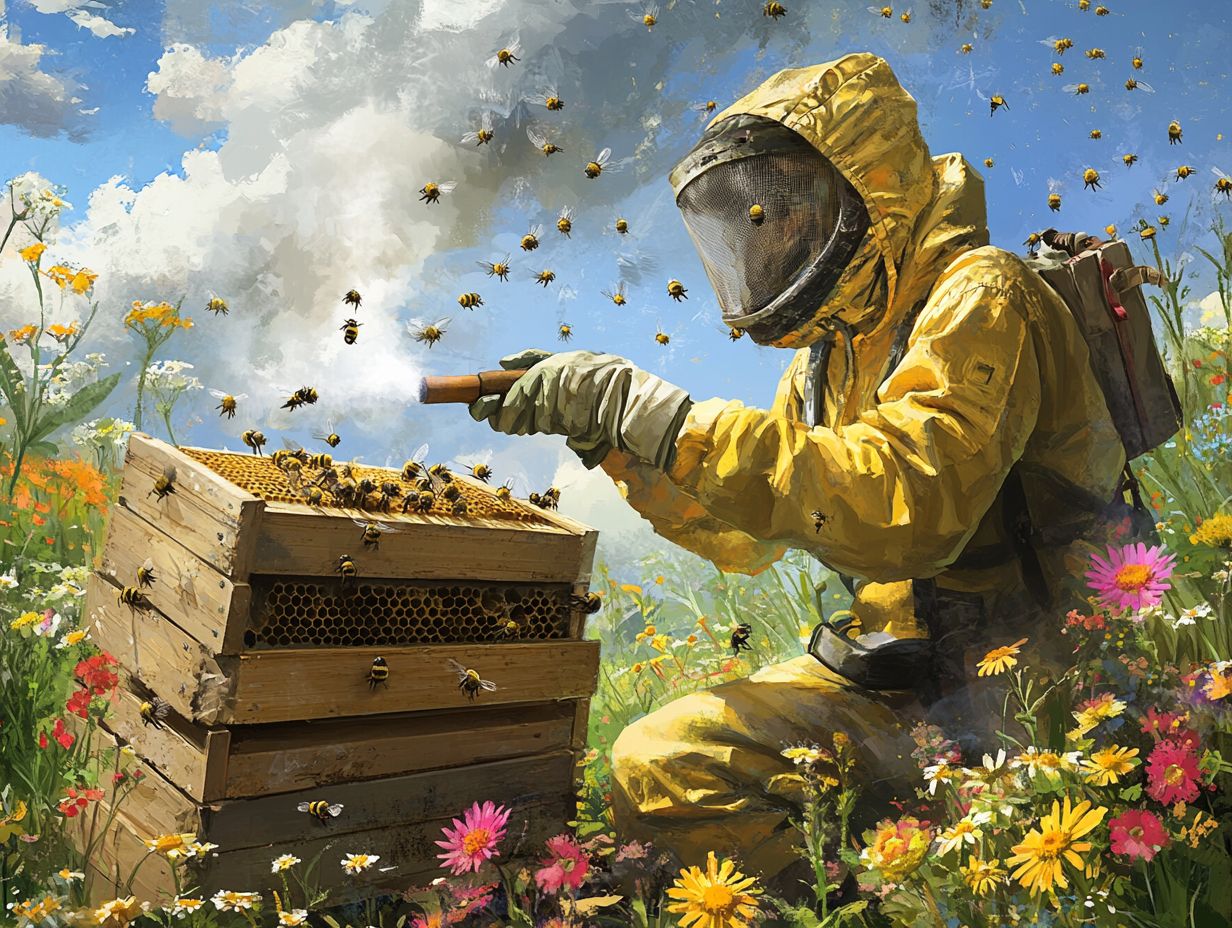
Protective clothing serves as your essential line of defense against aggressive bees, enabling you to manage your hives with confidence and safety.
When you handle honey bees especially during those times of heightened aggression wearing the right gear, such as bee suits and gloves, can drastically cut down your chances of getting stung.
This protective equipment not only shields you from physical harm but also allows you to approach your work with a calm mindset, helping to ensure that your movements don t provoke further aggression from the bees. By wearing the right outfits, you create a safer space, allowing you to maintain better control during hive inspections and promote the overall health of your colonies.
Investing in face veils and sturdy boots rounds out your protective gear, forming a solid barrier against potential attacks. It s vital to move slowly and methodically around the hive; quick movements can easily startle the bees and trigger their defensive instincts. A queen excluder is a device that keeps the queen bee in her specific area of the hive, and using one can also help manage hive populations more effectively.
Keeping a calm demeanor is essential for maintaining the bees tranquility; taking deep, steady breaths can work wonders in easing any tension. Having a strategic plan for hive management during aggressive periods not only safeguards your safety but also creates a peaceful environment for the bees.
Make sure your gear fits well and check it regularly. This simple habit boosts your protection and keeps you safe!
What Other Equipment Can Help with Bee Safety?
Beyond protective clothing, there are several other essential pieces of equipment that can significantly enhance your bee safety and streamline your hive management. These include:
- Queen excluder
- Wax foundation
- Tools for lifting hives
For instance, a bee brush allows you to gently escort bees away from the hive entrance, minimizing disruptions and reducing the risk of bee stings during your inspections. It is a part of essential beekeeping equipment that ensures a smooth apiary operation.
A queen excluder is invaluable, as it keeps the queen securely within designated sections of the hive, ensuring your honey bee colony remains well-structured and organized. Integrating plastic frames alongside the excluder can further enhance hive management.
Implementing a mouse guard effectively deters unwanted pests from invading your hives, providing an additional layer of protection for your honey bees.
Each of these tools contributes uniquely to promoting bee safety and ensuring a harmonious beekeeping experience for you. Utilizing a first aid approach when handling bees and ensuring proper ventilation in the hive contributes to a safer environment.
1. Bee Brush
A bee brush is an essential tool for your hive management, specifically crafted to help you handle bees gently while minimizing stress and the risk of stings. With its soft bristles, this tool allows for the safe and effective removal of bees from frames and hive entrances without causing harm. Using a bee brush is essential for safe hive management handle your bees gently! By incorporating a bee brush into your routine, you can cultivate a calm environment during inspections, which is essential for the safety of the bees. This gentle approach not only protects you but also creates a healthier atmosphere for the honey bees, leading to more productive hives.
To utilize the bee brush effectively, you ll want to adopt a few straightforward techniques:
- First, approach the hive slowly, giving the bees a moment to acclimate to your presence.
- A light, sweeping motion with the brush can gently dislodge bees, encouraging them to move aside without feeling threatened.
Focus on the specific areas where you need access, minimizing disruption to their natural behavior. Prioritizing bee welfare during hive management is crucial, as stress can throw their hierarchy and productivity into disarray.
When selecting a quality bee brush, look for one with durable, soft bristles to enhance your handling experience. Regular maintenance is key; clean the brush after each use and inspect it for wear to ensure its longevity and optimal performance.
2. Queen Excluder
A queen excluder is an essential tool in your hive management arsenal, carefully made to ensure the safety and well-being of your honey bee colony by confining the queen to designated areas within the hive. This clever device allows the worker bees to pass through while effectively preventing the queen from venturing into sections reserved for honey storage or brood rearing.
By maintaining the proper structure of the colony, a queen excluder minimizes potential aggression and chaos during hive inspections, thereby enhancing the safety of your bees. Utilizing this tool fosters healthier colonies and creates a more organized beekeeping experience.
Incorporating a queen excluder into your hive management practices streamlines the honey harvesting process and reinforces the queen s vital role in sustaining colony productivity. When installing these excluders, ensure they fit snugly to avoid any gaps that might unwittingly allow the queen to escape. Regularly monitoring its condition is crucial, as any damage could disrupt the hive s delicate organization.
For optimal results, select excluders crafted from durable, bee-friendly materials to enhance their longevity. Additionally, cleaning the excluders between uses prevents the buildup of residues that could impair their functionality, ultimately safeguarding the health and efficiency of your entire bee colony.
Don’t wait get your queen excluder today to ensure a thriving colony!
3. Mouse Guard
A mouse guard is an essential component of your hive’s defense, safeguarding your honey bees from potential pests, especially during the winter months when they are most vulnerable. This clever device prevents mice and other small animals from invading the hive and wreaking havoc on the colony’s structure and resources. By implementing a mouse guard, you can protect your colonies and reduce stress on your bees, fostering a healthier environment. For any beekeeper committed to maintaining bee safety and colony integrity, this protective measure must be a priority.
There are various types of mouse guards available, including drilled wooden blocks and wire mesh screens, each designed with unique functionalities tailored to protect your hives. Some designs allow for easy access for bees while keeping larger intruders at bay, highlighting the importance of selecting the right type based on your specific hive configurations and local wildlife.
Seasonal considerations are pivotal when deciding when to install and remove mouse guards; ideally, you want to get them in place before winter arrives. Regular monitoring and maintenance of your mouse guards are crucial, as damaged or poorly fitting guards can jeopardize the safety of your hive. Assess your local environment to choose a guard that effectively withstands regional challenges, ensuring optimal protection throughout the season.
Protect your bees with a reliable mouse guard!
4. Honey Extractor
A honey extractor is an essential tool for you as a beekeeper, carefully crafted to harvest honey from honeycombs while minimizing disruption to your bee colony. This remarkable equipment utilizes centrifugal force the spinning motion that pulls honey from the frames to spin honey out of the frames, enabling you to collect honey without the need for extensive hive openings. By employing a honey extractor, you can streamline your harvesting process while prioritizing the safety and well-being of your bees. This approach facilitates efficient honey collection and reduces stress and potential aggression from the bees during the entire process.
You’ll find a range of honey extractors available on the market, including both manual and electric options tailored to various needs and preferences. Manual extractors offer a hands-on experience that fosters a more intimate relationship with your hive, while electric extractors provide enhanced efficiency, particularly beneficial for larger operations. Regardless of which type you choose, it is essential to operate the extractor correctly to uphold bee safety and maintain hive integrity.
To ensure the longevity and continued effectiveness of your extractor, regular maintenance is vital. Be sure to clean the extractor thoroughly after each use and inspect it for any signs of wear and tear that could impact its performance. Adequately lubricating moving parts will guarantee smooth operation and help extend the lifespan of this essential equipment.
Invest in a honey extractor today for a more efficient harvesting experience!
5. Uncapping Knife
An uncapping knife is your go-to tool for honey harvesting. It’s expertly designed to remove the wax cappings from honeycombs with efficiency and safety. This specialized instrument allows you to access the golden nectar while keeping the bees undisturbed.
By choosing a high-quality uncapping knife, you can make the harvesting process easier and focus on the safety and well-being of your bees. This thoughtful approach keeps the bees calm and happy, significantly reducing stress on the colony during honey extraction.
These knives come in various types, including electric and manual options, tailored to meet different needs and preferences. Materials can vary from durable stainless steel to heated variants that make the uncapping process quick and effortless. By employing proper techniques like using gentle strokes and working in a well-ventilated area you can enhance bee safety significantly.
When selecting your uncapping knife, consider factors such as size, weight, and handle ergonomics. These elements can greatly influence both your enjoyment and efficiency during the harvesting process. Regular maintenance, including thorough cleaning and sharpening, will ensure optimal performance and extend the life of this essential beekeeping tool.
Frequently Asked Questions
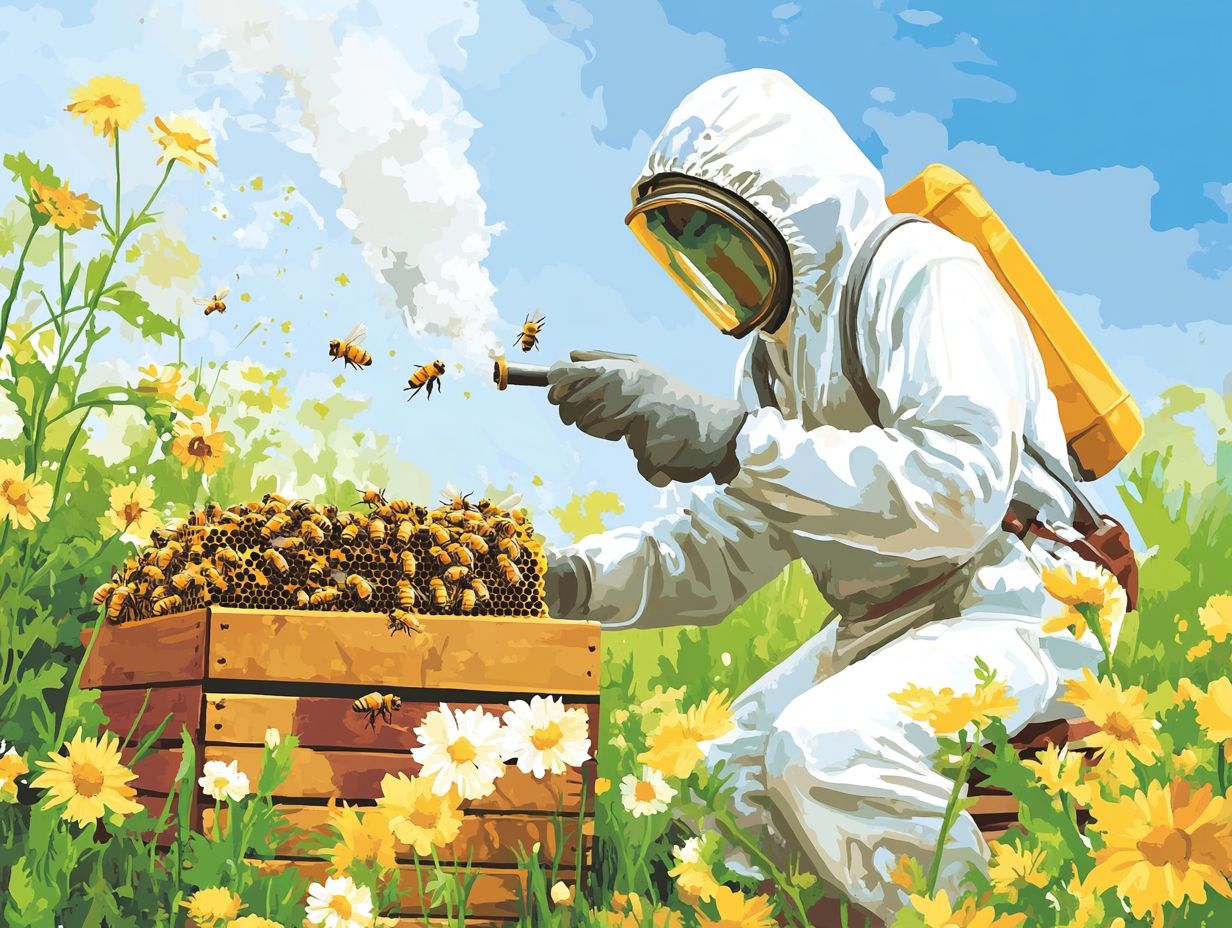
What is the importance of safety equipment for bee safety?
The use of proper safety equipment is crucial for bee safety as it helps protect beekeepers from stings and other potential hazards while working with bees. Bee suits, bee veils, and beekeeping gloves are important gear to consider.
What are some essential beekeeping equipment for bee safety?
Essential beekeeping equipment for bee safety includes a bee suit, bee veil, beekeeping gloves, smoker, and hive tool. It’s a good idea to have a first aid kit on hand.
Why is it important to wear protective clothing like a bee suit?
Wearing protective clothing like a bee suit provides a physical barrier between the beekeeper and the bees. This protection minimizes the risk of stings and other potential hazards, essential for ensuring bee safety.
What are the benefits of using a bee smoker?
A bee smoker is essential for bee safety as it calms the bees, making them less likely to sting. It also masks the beekeeper’s scent, making it harder for bees to detect them. Using a smoker before opening the hive can significantly reduce heat stress for the bees.
Can bee safety equipment prevent bee stings completely?
No, beekeeping safety equipment cannot prevent bee stings completely, but it significantly reduces the risk and severity of stings. Regularly attending a beekeeping club can help you learn proper techniques to minimize risks.
How often should beekeeping equipment be inspected and replaced?
To ensure bee safety, equipment should be inspected before and after each use. Any damaged or worn-out equipment should be replaced immediately. Keeping up with guidelines from organizations like the Country Fire Authority and consulting resources like The Lancet can provide further insights.

